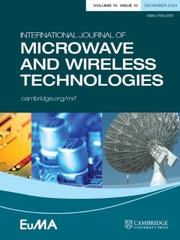No CrossRef data available.
Efficient modeling of a two-terminal polarization convertor–loaded dielectric-built filtenna using ML algorithms
Published online by Cambridge University Press: 03 November 2025
Abstract
In this study, a metasurface (MS) polarization converter combined with a two-port dielectric antenna is constructed and studied. The feeding configuration, which consists of a printed line connected to an aperture, offers built-in filtering capabilities. In addition to converting linear to circular polarization between 2.49 and 3.25 GHz, the suspended MS layer enhances port isolation to less than −20 dB. In addition, the suggested radiator’s |S11| is projected using the Random Forest and XGBoost machine learning (ML) models, which demonstrate satisfactory agreement with simulation data. The antenna effectively functions over 2.33–3.35 GHz, demonstrating that it is a leading contender for sub-6 GHz 5G communication systems. Fabricated measurements support both simulation and ML predictions.
Information
- Type
- Research Paper
- Information
- Copyright
- © The Author(s), 2025. Published by Cambridge University Press in association with The European Microwave Association.


